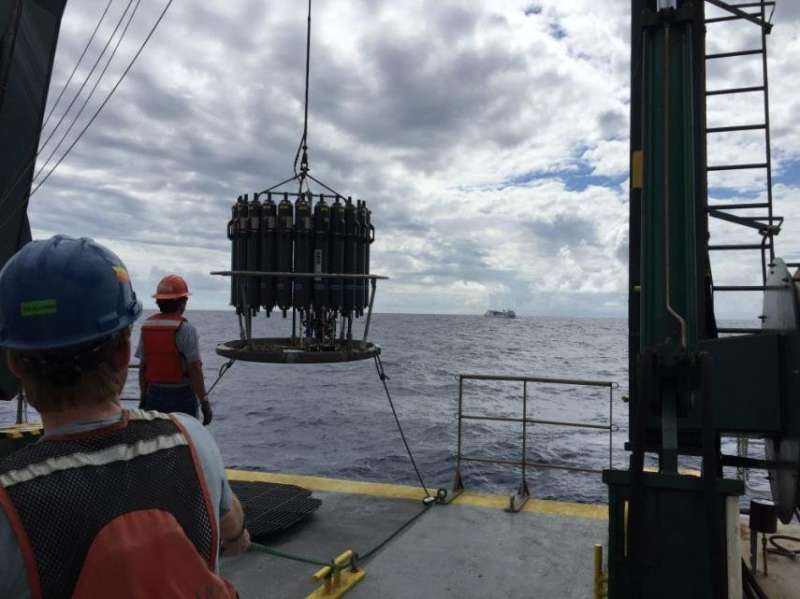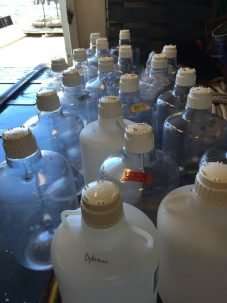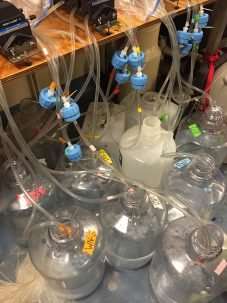The water sampling device, called a rosette, is lowered off the back of the ship into the North Pacific. Each of the 24 grey bottles can hold 12 L of seawater that was used for sampling.The ship in the distance is the R/V Ka’imikai-o-kanaloa, the sister ship of this expedition. Credit: Kyle Frischkorn
In the world's oceans, microbes capture solar energy, catalyze key biogeochemical transformations of important elements, produce and consume greenhouse gases, and comprise the base of the marine food web. Microbial ecologists working within Sonya Dyhrman's laboratory at Lamont-Doherty Earth Observatory strive to understand the oceans' ecosystem processes by studying a multitude of creatures, most too small for the human eye to see. These are the tiny microbes called phytoplankton that live beneath the ocean's surface, taking in carbon dioxide, sunlight and nutrients to produce oxygen. That oxygen is essential to human survival.
"One of our lab's mottos is 'take a breath, thank a phytoplankton,'" said researcher Matthew Harke. Diatoms, a type of microscopic phytoplankton, are estimated to produce one-fifth of the oxygen we breathe.
"The unseen microbial world underpins fisheries, climate, and the very function of ocean ecosystems, and we want to know how those ecosystems are going to shift in the future," explains Dyhrman.
Among the questions driving Dyhrman's team is: how do these all-important diatoms survive and thrive under difficult conditions? A new study authored by Harke and members of the Dyhrman team published today in ISME sheds light.
"Based on this latest research, we should probably change our lab motto to 'take a breath, thank a phytoplankton and their friends,'" said Harke. His discovery characterizes a symbiotic relationship between diatoms and bacteria. "We had a feeling this friendly relationship was critical to the diatom's success, but their relationship was largely uncharacterized," said Harke.
Harke and the team's research describes a function similar to that of human digestion.
Twenty-liter carboys lined up on the deck of the R/V Kilo Moana, waiting to be filled with sea water from the North Pacific Subtropical Gyre. Credit: Kyle Frischkorn
"We know that the human microbiome is critically important to our health—we couldn't digest our lunches without the many helpful bacteria that live with us! With my research, we're showing that phytoplankton rely on helpful bacterial partnerships too," said Harke.
The microscopic organisms the team was interested included a diatom and its symbiotic nitrogen-fixing cyanobacteria partner. Because these organisms are very difficult to culture in the lab, the Dyhrman team had to sail to the middle of the Pacific Ocean, hundreds of miles off the coast of Hawaii, to find them. This is a large region of ocean trapped by currents known as the North Pacific Subtropical Gyre (NPSG). This sequestered water forms an ecosystem that tends to be low in resources, such as nitrogen and phosphorous. It is a kind of ocean desert compared with coastal ecosystems that are nutrient rich. Here, the Dyhrman lab has been taking part in an ongoing, collaborative effort known as the Simons Collaboration on Ocean Processes and Ecology, or SCOPE. The study, funded by a multi-million-dollar grant provided by the Simons Foundation, engages scientific partners around the world. The team sifted through thousands of liters of seawater, which they collected over four days in July of 2015.
"Because they're microscopic, we used molecular tools to explore these interactions. From the filtered water, we sequenced all of the genes that were turned on and off by this partnership and used supercomputers to reconstruct how their metabolisms were intertwined over day-night cycles," explained Harke.
Importantly, the research suggests these "friends" can help diatoms survive the harsh conditions of the open oceans where plant nutrients are scarce. For instance, the research witnessed shared gene expression patterns indicative of sharing of resources needed for growth. The diatom's "friend" in this partnership is able to capture nitrogen gas and convert it to a useable form, feeding the diatom much needed nitrogen in exchange for protection (diatoms have a glass-like shell) and carbon. The research also found genetic evidence for how the two organisms stay together and reproduce.
"With this study, we have provided a new view of how this partnership works, providing insight into a baseline that we'll need to study to predict what to expect in a future ocean," said Harke. The NPSG is one of the largest biomes on Earth. "As the climate continues to change, these oligotrophic [nutrient starved] oceans are predicted to expand, likely making these partnerships more important."
Each sample that went into Matthew Harke’s project required filters 60 liters of seawater—the filtering station set up by the Dyhrman Lab started to look a little bit like a many-tentacled sea creature. Credit: Kyle Frischkorn
Provided by Columbia University

























